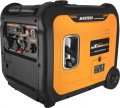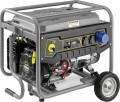Alternator
The type of alternator provided in the unit.
The alternator is the part of the generator that is directly responsible for generating electricity. Such a system works on the principle of the movement of wires (coils) in a magnetic field, due to which an electric current arises. However, the features of the work of the alternator can be different, on the basis of which they are divided into types:
asynchronous ,
synchronous,
inverter and
duplexes. Here are the main features of each option:
— Asynchronous. The simplest version of the alternator. The rotor (rotating part) in such models during rotation is somewhat ahead of the movement of the magnetic field created by the stator (fixed part) — hence the name. The practical advantages of asynchronous alternators are simplicity, low cost, good protection from external influences and insensitivity to short circuits and prolonged overloads. The latter makes them the best choice for powering welding machines. In general, asynchronous generators are designed mainly for active loads: lighting devices, computers, electric heaters, etc. For reactive loads (with coils and capacitors), it is better to use synchronous units (see below). It is also worth noting that in an asynchronous alternator, the voltage and frequency of the output current directly depend on the rotation speed; t
...herefore, such devices are particularly demanding on the stability of the drive motor.
— Synchronous. In this type of alternators, the rotation of the rotor and the magnetic field of the stator coincide (unlike asynchronous models). Synchronous generators are somewhat more complex in design and more expensive, they are more sensitive to short circuits and prolonged overloads. On the other hand, such a unit does an excellent job with both resistive and reactive loads: for a short time, it is able to deliver a current many times higher than the rated current, thus providing the necessary starting current for the reactive load. In addition, the design of synchronous generators includes an automatic control unit that outputs a stable voltage and is able to compensate to a certain extent for fluctuations in the speed of the drive motor. However, in terms of voltage stability, synchronous models are still inferior to inverter ones (see below).
— Inverter. Synchronous generator (see above), equipped with an additional electronic unit — an inverter. This block provides double current conversion: from AC to DC and then back to AC. Such devices are not cheap, but they have a number of advantages. Firstly, the output is a very stable current, practically without any jumps and fluctuations. Secondly, the generator is able to regulate the operation of the engine depending on the load: for example, if the load is half of the output power, then the current engine power is halved; this results in significant fuel savings. Thirdly, inverter models are lighter and more compact than traditional generators, and they are less noisy. It is such a generator that is considered the best choice for a load that is sensitive to the quality of the current, such as audio equipment or a TV. At the same time, units of this type have a relatively low power and are not designed for long-term operation or high starting loads, and therefore they are used only as backup power sources for relatively low-power power supply systems. In addition, when choosing an inverter generator, it is worth clarifying the shape of the output signal: not all models give an perfect sine wave — there are also units with a trapezoidal pulse that are not suitable for delicate equipment.
— duplex. Type of alternators developed by Endress and used mainly in generators of this brand (although devices from other manufacturers are also found). According to the creators, such an alternator combines the advantages of synchronous and asynchronous models. So, on the one hand, it is able to withstand high inrush currents without compromising the supply of other consumers, and the design usually has an auto-voltage regulator at the output; on the other hand, most of these generators can also be used to power welding machines, and the number of high-frequency harmonics at the output is very low. The disadvantages of "duplexes", in addition to the high cost, include the need to configure for a specific set of connected devices.Engine size
The working volume of the engine in a gasoline or diesel generator (see "Fuel"). Theoretically, more volume usually means more power, but in fact, everything is not so clear. Firstly, the specific power strongly depends on the type of fuel, and in gasoline units, also on the type of internal combustion engine (see above). Secondly, similar engines of the same power can have different volumes, and there is a practical point here: with the same power, a larger engine consumes more fuel, but by itself it can cost less.
Power
The operating power of the engine installed in the generator. Traditionally stated in horsepower; 1 HP approximately equal to 735 watts.
First of all, the rated power of the generator directly depends on this indicator (see above): in principle, it cannot be higher than the engine power, moreover, part of the engine power is spent on heat, friction and other losses. And the smaller the difference between these capacities, the higher the efficiency of the generator and the more economical it is. However high efficiency affects the cost, but this difference can pay off with regular use due to fuel savings.
Fuel consumption (50% load)
Fuel consumption of a petrol or diesel generator when operating at half power, and for combined models when using petrol (see “Fuel”).
Fuel consumption usually increases with load. However, generator efficiency is not always linear - fuel consumption may vary disproportionately with different loads. In this case, the approximate amount of fuel consumed by the generator when operating at half power (50% of the rated power) is given. Knowing the fuel consumption and tank capacity, you can at least estimate how long one fill-up will last.
Fuel tank volume
The volume of the fuel tank installed in the generator.
Knowing the fuel consumption (see above) and the capacity of the tank, you can calculate the operating time on one gas station (if it is not indicated in the specifications). However, a more capacious tank is also more bulky. Therefore, manufacturers choose tanks based on the general level and "voracity" of the generator — in order to provide an acceptable operating time without a significant increase in size and weight. So in general, this parameter is more of a reference than practically significant.
As for the numbers, in low-power models, tanks are installed for
5 – 10 liters, or even
less ; in heavy professional equipment, this figure can
exceed 50 liters.
Total number of sockets
The total number of sockets for 230 and/or 400 V provided in the design of the generator.
This number corresponds to the number of devices that can be simultaneously connected to the generator without using splitters, extension cords, etc. If it is a three-phase model (see "Output voltage") with different types of sockets, it is worth specifying the quantity of each type separately, as different models may have varying configurations. For example, a unit specified as having
3 sockets might have 1 three-phase socket and 2 single-phase ones, or 2 three-phase and 1 single-phase socket. Generally, the most basic modern generators have only
1 socket, though models with
2 sockets are more common; and the most powerful models can have
4 or more sockets.
It is also important to remember that the ability to connect various devices is limited not only by the number of sockets but also by the generator's rated power (see above for more details).
Sockets 230 V
The number of 230 V sockets provided in the design of the generator, as well as the type of connectors used in such sockets.
The type of connector in this case is indicated by the maximum power that is allowed for the outlet - for example, “2 pieces for 16 A”. The most popular options for 230-volt outlets are
16 A,
32 A, and 63 A. We emphasize that amperes in this designation are not the actual power that the generator can produce, but the outlet’s own limitation; the actual power value is usually noticeably lower. Simply put, if, for example, the generator has a 32 A socket, the output power on it will not reach 32 A; and the specific number of amperes will depend on the rated and maximum power of the unit (see above). So, if for our example we take a rated power of 5 kW and a maximum of 6 kW, then to a 230 V outlet such a generator will be able to produce no more than 5 kW / 230 V = 22.7 A standard and 6 kW / 230 V = 27, 3 A at its peak. And if the power has to be divided between several outlets, then it will accordingly be even less.
As for specific types of connectors, the higher the power permissible for the outlet, the higher the requirements for its reliability and quality of protection. In light of this, as a rule, higher power outlets can be connected to lower power plugs (directly or through an adapter), but not vice versa. And if there are several sockets, by their type it i
...s possible to estimate with some certainty the distribution of the entire power of the generator between them: between two identical sockets such power is usually divided equally, and more power is allocated to an socket with a larger number of amperes and power. However, specific details on this matter should be clarified separately in each case; It's also worth considering 400V outlets, if available (see below).USB charging port
The generator has
a USB connector(one or more) for charging various devices. Most modern smartphones and tablets can be charged from USB, and this charging method is also found in many other equipment - from cameras and flashlights to electric screwdrivers and radio-controlled models. The standard supply voltage through this connector is 5 V, but the power may be different, it should be specified separately.
Output 12 V
Existence in the generator of an
output with a direct current and voltage of 12 V. The main function of this output is to charge car batteries, as well as power devices originally intended for cars (recall, 12 V is the standard voltage of on-board networks in cars).
The following types of 12-volt outputs are found in generators:
- Terminals. Terminals are used to connect wires directly without using any plugs. This connection is the most reliable.
- Socket. Socket outlet for a plug with two flat pins, designed to connect 12-volt consumers. Holes in sockets come in different layouts, which you need to pay attention to.
- Cigarette lighter. The so-called "car socket", which in many cars is combined with a cigarette lighter socket (hence the name). Such connectors are used to power various automotive devices and accessories.

